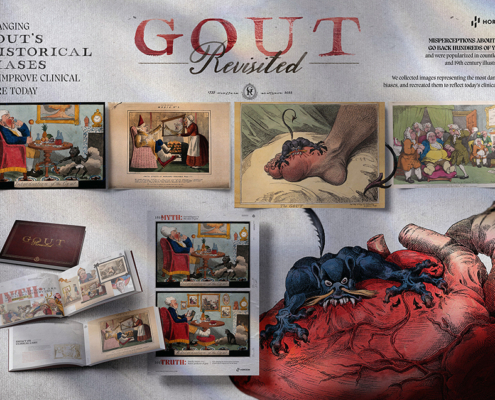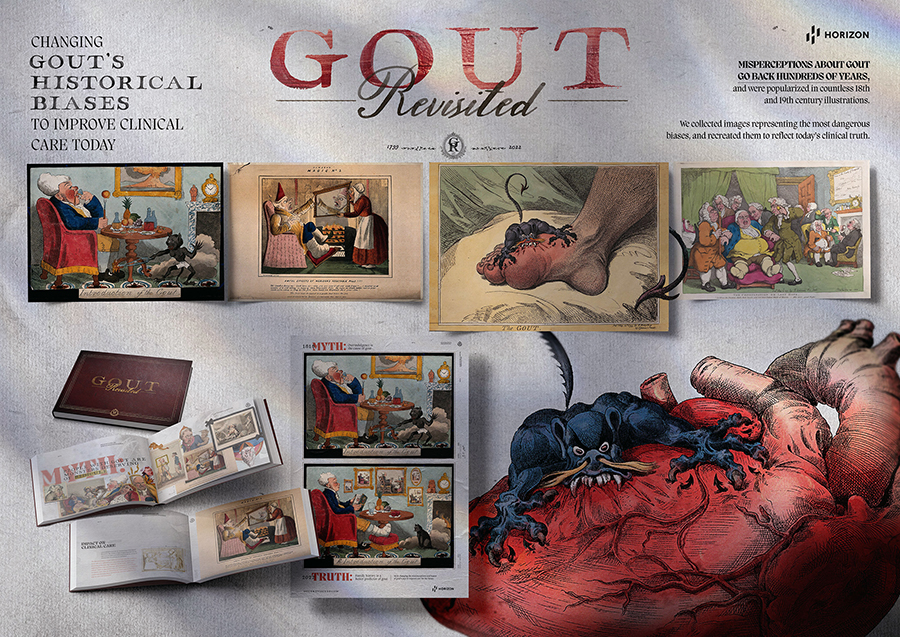OCI 2022: Horizon Therapeutics – Removing barriers, breaking down misconceptions
By Maria Fontanazza • [email protected]
Horizon Therapeutics achieved third place in the 2022 OCI top companies ranking namely for its “Gout Revisited” campaign, which seeks to remove the stigma of gout, a disease that has been largely coined as an affliction of the “overindulgent, rich white man.” Keli Walbert, executive vice president, U.S. Operations, at Horizon Therapeutics shared insights with Med Ad News about the company’s strategy in debunking gout myths and steering the message in the right direction.
Med Ad News: What does it mean for your company to be recognized among the most innovative and creative companies and brands in the industry?
Keli Walbert: One of the things that really drives Horizon’s innovative approach is the personal story of our CEO, Tim Walbert. He suffers from a rare disease and autoimmune disease, and it brings a different level of personal commitment to patients we are trying to help, as he’s a patient, too. Personally, I approach every opportunity with the mindset of a caregiver and the firsthand insights of what those living with rare diseases take on every day.
Across Horizon, the personal connection creates a culture that is deeply moved to act for patients and fuels every decision we make, from the medicines we develop to the communities we support and the creative passion we deliver to reach audiences. We strive to deliver innovation with impact, helping to change perceptions – as in the case of gout – and create awareness for rare disease that have not had a therapeutic option before – as in the case of thyroid eye disease.
We talk with patients and doctors, and we learn what their struggles are, and we put together programs to remove those barriers and struggles. As a company that puts patients first, our most important recognition has been when we transform the lives of patients.
Med Ad News: What were the objectives and messages of the work for the “Gout Revisited” campaign?
Keli Walbert: Gout is often misunderstood, even by doctors. Many current misconceptions can be traced to 19th century political cartoons depicting the disease. These iconic illustrations still appear in medical textbooks, journals, and peer presentations. The myths they portray touch on race, gender, social status, stigma, and disease presentation.
The ubiquitous images, and the biases they perpetuate, contribute to gout being underdiagnosed, underprioritized, and undertreated, with negative patient outcomes. Our objective was to influence the influencers (250 top rheumatologists and KOLs) and correct the myths that began centuries ago but still impact treatment today.
Our message: The ever-present images of gout are demeaning and wrong, and they may be unknowingly preventing rheumatologists from providing the best possible treatment to a wide variety of gout sufferers.
Med Ad News: What creative strategy was used to connect with the target audience for “Gout Revisited”?
Keli Walbert: We conducted the first clinical study into the stigma of gout among rheumatologists. 106 rheumatologists were interviewed about their perceptions of patients with uncontrolled gout. Results were published in a poster presented at the 2021 American College of Rheumatology Convergence event. Insights revealed that despite good intentions while treating their patients, rheumatologists’ causal beliefs and illness perceptions about gout reflected negative stereotypes, with critical implications for attributions of causality and treatment recommendations. Many of these biases can be traced directly back to the cartoons and illustrations of gout popularized in the 19th century.
By debunking the prevalent subconscious biases that gout only impacts the foot, is caused by over-indulgence, affects only the wealthy, only impacts white men, and is a self-inflicted disease deserved by patients, we are speaking directly to the cases these physicians treat daily. The hope is to correct biases of the past to improve care today.
Med Ad News: What were the challenges you faced, and how did creativity help you overcome those challenges?
Keli Walbert: These harmful images are ubiquitous in rheumatology. And the biases they perpetuate are reinforced with every view.
To disrupt the negative feedback loop, we started “at the top” and influenced the influencers. Conversations with KOLs were positive, and the impact was almost immediate. Within a month of launching our campaign, the updated images had been appropriated by KOLs, replacing the old, biased illustrations which traditionally led off their presentations at congresses and round tables. This swap sparked conversations and drove a large endorsement of our message.
With KOL support, we then set the record straight within high-volume practices. We shared the new imagery with rheumatologists online and in person – with a dedicated microsite and in-office materials such as posters and “coffee table” books. Efforts across mediums have been hugely successful; over 80% of our target list actively engaged with the campaign.
By correcting gout’s harmful historical record, we inspired rheumatologists to reflect on their own biases, and bring a reformed clinical and personal mindset to their practices.







 BioSpace
BioSpace

